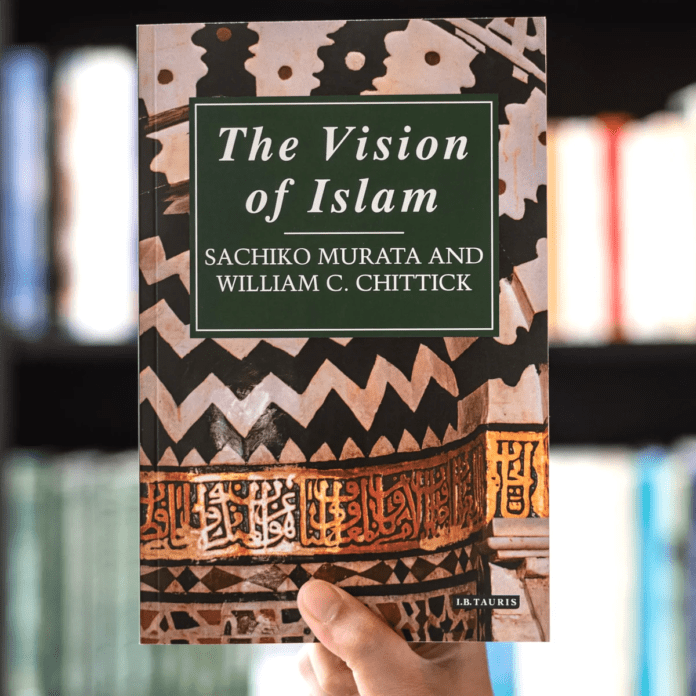So tell the tale — perhaps they will reflect. [Koran 7:176]
“The Vision of Islam” authored by Dr. Sachiko Murata and Dr. William C. Chittick delves into the multifaceted aspects of Islam, including practice, faith, spirituality (Ihsan), and the Islamic perspective on history, drawing from the teachings of the Hadith of Gabriel. Dr. Israr Ahmed (may Allah bless him) held a deep appreciation for this book, fervently endorsing it to all Muslims. Here are some excerpts shared with permission.
The Signs of God
The Koran is God’s speech, directed at human beings. Whatever God says in the Koran is an expression of himself. In the same way, when we speak, we express ourselves. We may be playing a role, but we ourselves have chosen the role, and no one else would play it the same way. Even the roles we play express something of ourselves.
When Muslim scholars study the Koran, they look at every chapter, every verse, every word, and every letter as God’s self-expression. There is nothing in the Koran that is not full of significance, because God has spoken with full awareness of what he is saying. In the case of human beings, we may not be aware of what we are expressing through our words, but God is not negligent and forgetful like us. Hence, he knows exactly what he is saying, and people can come to understand his speech to the extent of their capacity. Ultimately, the whole religious enterprise in Islam involves understanding the Koran and embodying its message through everyday life.
The Koran gives people news of God, since it is God’s purposeful and intentional speech, directed at them. Everything in the Koran is an indication or an intimation of God’s self. This helps explain why the Koran refers to its own words and sentences as signs (ayat):
We have sent down upon thee signs, clear indications, and none denies their truth save the transgressors. (2:99)
These are the signs of the Wise Book. (10:1)
These are the signs of the Manifest Book. We have sent it down as an Arabic Koran. (12:1-2).
If the Koran expresses God, however, it is not the only thing that expresses him. Other scriptures also express him, and so do his creatures. The Koran employs the word aya (sign) in almost four hundred instances, in the most general sense to anything that gives news of something else. In a slightly more specific sense, the word is used to refer to everything in the heavens and the earth, inasmuch as it gives news of God. All things are signs of God for the same reason that they are muslim—because they submit to God’s creative power. Everything that happens in time tells us something about God’s activity within creation. Signs are found not only in the natural world and historical events, but also inside ourselves:
We have appointed the night and the day as two signs. (17:12)
And a sign for them is the dead earth, which We brought to life and from which We brought forth grain that they eat. (36:33)
And of His signs is the creation of the heavens and earth, and the variety of your tongues and colors. (30:22)
And of His signs are the ships that run on the sea like landmarks. (42:32)
In the earth are signs for those having certainty, and in your selves. (51:21)
The Koran uses the term sign in a still narrower sense, to refer to the miracles and scriptures that are given to the prophets as proof that they have come with messages from God. Through signs, God’s messengers show people the significance of history. Just as all prophets and all followers of the prophets are muslims, so also all the prophetic activities give signs of God’s wisdom and power:
They said [to the prophet Salih], “You are merely one of those who are bewitched. You are merely a mortal, like us. Then produce a sign, if you are one of the truthful.” (26:154)
And We sent Moses with Our signs, and a manifest authority, to Pharaoh and his council. (11:96)
So when Moses came to them with Our signs, clear indications, they said, “This is nothing but a forged sorcery.” (28:36)
In Joseph and his brethren are signs for those who ask questions. (12:7)
Finally, in the specific sense that we have already encountered, the Koran refers to its own words as signs, and the term came to be applied technically to each of the subunits of the suras.
In short, the word sign can be applied to anything at all, since all things are God’s creatures. Everything in the universe is an ayatollah (a sign of God), though this particular expression—which has become well known because of modern political events—has recently come to be applied to some of the ulama. Even Satan is an ayatollah, a sign of God. His activity, as we will see later, also manifests God’s wisdom in creation.
Before leaving the term sign, it is important to state explicitly something that is implicit in the word: A sign is put there for people to read. People do not set up signs or give indications unless they want to convey a message. The Koranic use of this term in at least three main senses alerts us to a fundamental insight of Islam, a point that Muslims find so self-evident they are often nonplused when non-Muslims do not grasp it immediately:
All of nature and scripture speaks to us directly, with a specific message, and God expects us to read the message and to react appropriately. When the Koran mentions God’s signs, it typically concludes with something like “Perhaps you will take heed,” or “Will you not understand?” or “Do you not see?”
The worst thing that human beings can do is to ignore the message that is before their eyes wherever they look—the message of tawhid:
How many a sign there is in the heavens and in the earth that they pass by, turning away from it! Most of them have no faith in God, and they associate others with Him. (12:105-106)
Who does greater evil than he who is reminded of the signs of his Lord, then turns away from them? (32:22).
Interpreting the Signs
The signs of God give news of God within the matrix of history. There are two basic kinds of signs: prophetic and natural. Prophetic signs can be divided into oral or written (scripture) and physical (miracles). The natural kind can be divided into external (pertaining to the world around us, whether nature or society) and internal (pertaining to our own selves). We will return to some of the prophetic signs when we discuss prophecy, and we will look more closely at external and internal signs when we discuss the cosmos and its relationship with the human being. At this point we want ask how the signs can help us understand the meaning of the word ‘God’.

By definition, signs are signs of God. If we understand the signs, we are understanding something about God. One way to grasp the message of the signs would be to look at the natural world and try to understand its language. In a certain sense, this is what modern science does; it is trying to understand the message of nature and the cosmos. However, science has certain presuppositions about the nature of reality, and hence it leaves aside the question of God, considering it irrelevant to the scientific enterprise.
The fundamental difference between the traditional Islamic approach to the natural world and that of modern science is that Muslims begin with the faith that “There is no god but God.” In other words, Muslims already know that the signs are signs of God, but they are trying to understand what God is saying. The scientists feel that, until we understand the natural phenomenon, we will never be able to know if there is a god or not. The result is two radically different points of view that cannot easily be brought together. Without pursuing this issue further, let us suggest an analogy for the difference between the Islamic and the scientific approach to things. Most people look at a painting—let us say a Michelangelo—and try to understand what the painter is saying. Opinions differ as to the exact message, but everyone agrees that what is important about the painting is what the painter is trying to get across.
However, we could also study the painting from the point of view of any of a dozen different sciences. We could analyze the canvas, the paint, the colors, the geometrical relationships among the objects, and so on. In these tasks we would have to make use of physics, chemistry, biology, geometry, and other sciences, and we could also make use of various other approaches that assume the validity of modern scientific knowledge, such as sociology, history, and psychology. This is all well and good, and there is no contradiction between looking at things in these ways and looking at them from within the Islamic perspective. But suppose that a group of the scientists began claiming that the painting had come to exist spontaneously. There was no painter, and if there was, he had no message to express, he was just throwing around tints haphazardly. And even if he had a message, we would have no way of understanding it.
For Muslims, the proof of tawhid is the way things are, just as for most people, the proof of the artist and his message is the existence of his painting. It is just as self-evident to traditional Muslims that God created the universe as it is self-evident to any sane person that someone painted the pictures hanging in a museum. This most basic insight of Muslims is sometimes referred to as “the religion of old women,” not to disparage it, but to suggest that there is no one so unintelligent as to miss the point. The expression derives from a story that is told about the Prophet.
One day, Muhammad was walking through town with some companions when he met an old and decrepit woman from one of the tribes who was making wool into thread with a spinning wheel. He greeted her and began speaking to her. He asked her if she had faith in God. She replied that she did. The Prophet asked her why. She replied that a spinning wheel does not turn unless there is a hand to turn it, and the heavens cannot turn unless someone is turning them. The Prophet looked at his companions and said, “You should have the religion of old women.”
But how much can people understand about God from the signs in the universe? This has been a perennial issue in philosophy and theology for a number of religions, and it is intimately tied to the question of whether or not human beings need revelation from God. The general Muslim view is that divine help is necessary to understand the signs. Trying to read the signs without prophetic guidance is like trying to understand speech without knowing the language, or without recognizing that it is speech.
The basic position of Muslims concerning knowledge of God, the world, and themselves is that people are ignorant. There are uncounted mysteries that can never be solved by human reason. However, that does not mean that people should give up trying to understand. Ignorance is curable, to some degree. The way to reach the remedy is to listen to the words of the prophets. More specifically, it is to accept that the Koran is the speech of God, full of the signs of God. To understand what the Koran says about God is to understand what God is telling human beings about himself. This position directly follows the acceptance of Muhammad as the messenger of God. In other words, God has a message, known as the Koran; Muhammad has brought it, and in order to understand what it has to say, we have to read it and study it. The theme of this message, as we saw above, is tawhid.

To the extent that generalizations are meaningful, we can say that Western scholars who have studied the Koran have searched for its significance in its historical context, the Judeo Christian background, social relationships, economic considerations, and linguistic factors. They have felt that the discovery of the historical and social circumstances surrounding the Prophet and the early community is of fundamental importance. Verses that refer to historical events need to be understood in terms of those events.
Certain elements of this modern Western approach to interpretation have been known to Muslims from earliest times, and often Western scholars are simply following in the footsteps of their Muslim predecessors. The great difference between this approach and the traditional Islamic approach is that Muslims never imagined that the meaning of a verse could be exhausted by its historical significance. If one wants to argue that the Koran has to be understood in terms of historical circumstances, the Muslim commentators can reply that the historical circumstance themselves are signs of God, and hence they have a significance that transcends the mundane: How can you understand the historical circumstances if you do not understand what these circumstances tell us about tawhid? The difference between signs found in scripture and signs found in nature is that the scriptural signs tell us explicitly and in so many words that this is a message of God. But human beings cannot grasp the divine message in historical signs without understanding the scriptural signs.
Both the modern and the traditional Islamic approaches to the interpretation of scriptural and historical signs agree that history has a meaning and that it can be understood if we grasp the causes of what occurred. In the modern Western approach, causality moves “from down to up”; that is, the meaning of concepts such as God, religion, community, human being, and history has to be sought in the constitutive elements that brought these concepts into existence. These elements can be natural, environmental, social, psychological, economic, and so on. In contrast, the Islamic approach works “from up to down.” It begins with tawhid, and then, on the basis of tawhid, attempts to situate everything else in relation to God. The meaning of a thing is found in its sign-ificance. The thing is a sign, and the sign speaks of God.
Muslims do not deny that the historical elements are important; the Koran itself makes their importance clear. When the Koran says that God sent every messenger speaking “the tongue of his people” (14:4), this is a specific reference to the idea that divine messages are adapted to the cultural, historical, and linguistic circumstances of the people to whom they are revealed. But to say this is also to affirm that they are divine messages. It is God who is speaking—Arabic or Hebrew or Sanskrit or Chinese as the case may be—and it is human beings who are listening. It is a far cry from this position to the position that humans made up the language and God along with it. At the risk of oversimplifying, one can summarize the difference between the traditional Islamic perspective on interpreting signs and the various modern approaches to historical understanding by reference to the Biblical saying, which the Prophet repeated [1], “God created human beings in his own image.“[2] Muslim scholars have taken this to mean that everything in the universe with which human beings have contact has to be understood in terms of the divine reality that determines human nature. Modern scholarship, however, takes a different view of the matter by reversing the saying. God is no longer taken as an active participant, but rather as a human construction. Hence, modern scholarship maintains that “Human beings created God in their own image.” For modern scholarship, the human origin of religion then explains the tremendous diversity of religious belief and practice found throughout history.
If we moderns are to grasp the logic of the Islamic vision of things, we need to keep in mind that, for Muslims, things begin with God and come down. For us (by and large), things begin with us and go up (or, what is more likely, in every which way). From the modern perspective, even speaking of up and down becomes problematic, since we have to choose a standard by which to judge directions, and people do not easily agree on such things.
To be Continued…..
Book References: [3]
[1] Hence Hadiths about human as image of God become irrelevant or cancelled:
https://quran1book.blogspot.com/2021/11/Fundamental-Hadiths.html)
[2] “God created human beings in His own image” (Hadith).
https://islamqa.org/hanafi/seekersguidance-hanafi/32888/ AlBukhari 6227,
[3] Vision of Islam:
https://www.amazon.com/Vision-Visions-Reality-Sachiko-Murata/dp/1557785163اردو ترجمہ مکمل کتاب http://www.williamcchittick.com/ wp-content/uploads/2019/06/
Chittick-and-Murata-Vision-of-Islam-Urdu-Translation-by-Muhammad-Suheyl-Umar.pdf https://salaamone.com/vision/




